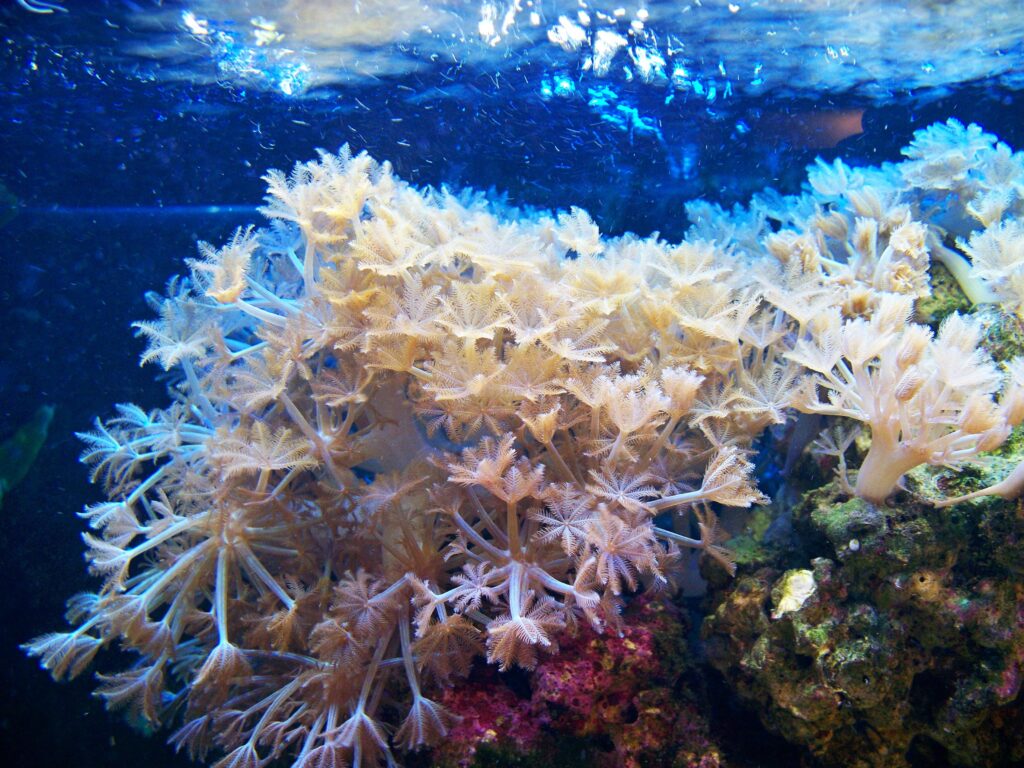Pulsing Xenia might not only take over your aquarium, They will take over your house.
Intimidated? Probably not.
You’ve probably heard a lot about the insane growing speed of The Pulsating Xenid.
You might have also heard about how it can survive without much care on your side.
You’ve probably heard more about its amazing features.
But have you heard about how to take care of it the right way?
Let us get to know all about this amazing Soft coral known as The Pulsating Xenid(Heteroxenia fuscescens).
Description and Habitat
Pulsing Xenia, belonging to the order Alcyonacea, are soft corals with an almost non-existent skeleton, unlike other corals such as candy cane coral.
They resemble multi-branched trees with thick branches, on which polyps are attached to the branch tips or surface. The Xenia polyps open and close like blooming flowers.
What you are interested in is its pulsing motion right?
Then you won’t be disappointed. The Pulsing Xenia is almost the only coral that you can add to your aquarium and expect it to show constant movement. Not small movements but real movements. Unlike other pulsing corals with polyps that will stay still all the time. You can get some action in your tank with the Pulsing Xenia.
And If you wanna see it pulsing constantly, you should keep it in low-flow water.
Since they originate from areas with low flow, they have developed the ability to pulse, which helps to bring oxygen to the water and keep the surrounding water clean.
Of course, you can keep it in medium and high-flow water but you won’t see much of the “ motion in the ocean”.
They are originally from Indonesia but nowadays they are mostly aquacultured which is a good thing for us hobbyists.
Lifespan: In the wild, it’s said that they live up to 10 years, but the aquacultured one might live longer or shorter.

Setting up The Aquarium
Now you’ll get more interested in this coral. You can literally put it in a bowl and it’ll colonize it(don’t do that!)
You can basically keep it in any tank you have. Whether a small (min 20gallon -75L) or a big aquarium the Pulsing Xenia will fit. They are ideal for people with small aquariums that want to get corals, and they are hardy and generally won’t fall sick and won’t require much care on your side so you won’t go wrong taking care of them as a beginner.
But still … you still need to offer it the right settings if you wanna let it thrive and “take over your tank”. Don’t worry we will discuss how to limit its growth if you’re afraid of it “taking over your house”.
So the most important thing you should know about setting it up in a tank is lighting.
Pulsing xenia basically rely on lighting to grow and live. So setting a good source of lighting is important.
You can keep them within a dimly lit aquarium, but I wouldn’t recommend it. Yes, they can survive but they won’t get to display all their amazing traits like that.
Keeping them in a brightly lit aquarium is the way for them to thrive. Cause that’s mainly where they get their most important nutrient aka photosynthesis. ( more on that later)
Water parameters
Typically the Pulsing Xenia can survive in a wide range of parameters, as I mentioned before they are hardy and will survive in bad conditions which other corals might die in.
So to ensure a stable environment for them you can consider these parameters:
Temperature: 72-80 Fahrenheit (24-27 celsius)
dKH: 8-12°
pH: 8.2- 8.5
Salinity: 1.023 – 1.025
Calcium Levels: 300 – 420 mg/L
If you are getting a frag from a store or from a friend, consider asking them in which parameters they are used to keep them. Sometimes different coals require different parameters.
Tank mates
Pulsing Xenia are peaceful and not venomous as other known corals, you can keep them whit whoever you want as long as they tolerate the same parameters.
You can pair them with Clownfish ( but the Bubble Tip Anemone is their favorite), and other corals without any problem. In fact, The Xenia will get “bullied” and stung when it tries to expand to other corals( a way to keep them in check- surround it).
I’ve heard they don’t do well with stony corals, but I haven’t tried this myself. If you have an idea about this, please let us know in the comments.
Tank placement
You should pay attention to the placement you are gonna put in your aquarium if you want to see it pulsing regularly. Try placing it in the least “low flow” area in your tank. This way it will “work hard” to attract nutrients and oxygen which means you’ll get more movement.
Also, it’s better to grow your Xenia on a rock, growing it in fine sand isn’t ideal.
(Not only it’s ideal to keep it in its own rock it will also prevent it from taking over your aquarium, this way you can keep it in check when it split and try to expand)
Care and Maintenance
They are totally beginners friendly and won’t require much nutrition.
If your aquarium is lacking in magnesium, phosphate, nitrate, and other trace elements(which most new aquarium lack), it will still survive. It’s just that it won’t grow quickly as in an aquarium with high element density.
because they prefer high-nutrient tanks, which facilitate their rapid growth (although some people are annoyed by this).
If your tank has a high density of nitrate and other elements, the Pulsing Xenia are perfect water cleaner. They will sweep them all. (Although it’s better t keep your nitrate in check don’t let it exceed 5ppm).
Ps: If you keep a Pulsing Xenia in a clean water tank it might get damaged. ( basically, you left it with nothing to eat).
Feeding
I have mentioned earlier that they get their nutrients from the lights but I didn’t explain how:
So basically Xenia species rely on Zooxanthellae for nutrition, these little species have the ability to photosynthesize, they basically generate oxygen and supply the coral with glucose, glycerol, and amino acids(which are absorbed from the light), and the coral will provide a safe environment for them, they are in in a symbiotic relationship.
In layman’s terms, Zooxanthellae are essential for the corals to live, if they die the coral dies, and if they live the coral live.
How to care for them
Just by performing regular water changes, you will see them thrive with no extra work on your side, and this is the reason soft corals are popular. (in fact, they prefer dirty water but for the sake of the fish living with it, if any, perform a regular water change.)
Reproduction
Well, you might have already guessed it now, they self-reproduce like wildfire. They form what we call daughters and spread them to expand in the aquarium.
Tips for controlling the spreading
I have mentioned some tips “on the way” through this guide to control and maybe stop the spread of its excessive expansion. Implementing just one of them is generally enough but there are still other things you can do.
Yes, you can trim the frags. Trimming the frag not only helps you control how much the Xenia spread, but you can also exchange them with friends and other hobbyists. You can also sell them to stores.
So the bulletproof method to control the spread of Xenia is:
- Getting on its own rock
- Surround it with aggressive corals
- Offer low nutrition
- Trim the frags
You might also want to learn how to properly cut the frags so as not to damage them.
Conclusion
I’m always amazed when I see pictures of Pulsing Xenia “taking over” other people’s aquariums. The rate at which it grows is amazing, you can’t help but admire it. Really.
There are some cases where people get a Pulsing Xenia but for some reason, they don’t see it thrive and expand as other people told them. This can be due to many reasons but I have covered the basic care for the Pusling Xenia in this guide. If your Xenia isn’t as active as it should be you might be doing something wrong or maybe the Xenia you have is different.
If you are not a fan of the Pulsing Xenia or you mainly don’t like how it spread you can consider getting a Bali Giant Xenia although it’s more expensive. The Bali Giant Xenia is basically a pulsing Xenia that doesn’t spread.
If you are a fan of corals(like me) and haven’t yet watched Chasing Corals on Netflix, You might just want to consider it. It’s an amazing documentary(i won’t spoil you). I highly recommend you watch it.
If you have any thoughts or something to add, Please share them with us in the comments.


2 thoughts on “Unveiling the mysteries of caring for Pulsing Xenia: Tips and tricks”